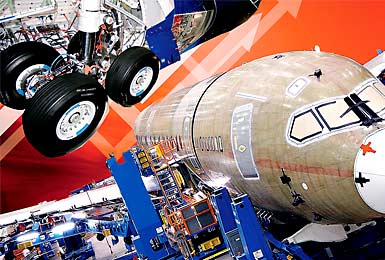Aerospace Focuses on Maintenance and Niche Business For Growth
Economic growth in the aerospace industry has been lukewarm, but companies large and small are taking advantage of middling advances to propel expansion.
June/July 10

Weak Recovery
Aerospace is a $150 billion industry in the United States and generates more than 1.3 million jobs, according to the Aerospace Industries Association. The AIA estimated in 2008 that sales last year would rise more than 4 percent to $214.1 billion, and it expects new business aviation orders to recover in 2010.
Some still anticipate turbulent times ahead, but there are bright spots. Bill Chadwick, director of the Aerospace Research Center at the AIA, says there's a favorable outlook for aerospace in the coming years. With financing opening up in the past year and the global economy showing potential for an upswing, there may be growth ahead. Chadwick notes that the last quarter of 2009 saw an uptick in sales.
"The end of last year was a lot better than we were expecting," he says. "The large civil aircraft, shipments, and net orders were a bit stronger. It shows that financing is firming up."
But the government could be planning to cut back its orders. In early May 2010, U. S. Air Force Secretary Michael Donley warned suppliers to expect a Pentagon focus on affordability. This comes from mounting competition as overseas firms, such as EADS in Europe, compete with Boeing to build a 179 refueling aircraft for the Air Force. And when President Obama called to dissolve the Constellation Program, it left two of NASA's largest contractors, Lockheed Martin and Alliant Tech Systems, potentially on the hook for hundreds of millions of dollars.
Forecasts for air traffic - a critical driver of the aerospace industry - have grown over the first months of 2010. Aerospace News reported that by the end of the year, traffic growth could reach 6 percent, compared to 4 percent in February and 4.2 percent in March. Nevertheless, orders for commercial aircraft have sharply declined at Boeing, dropping 16 percent from April to May. The company is still planning to ramp up production and Randy Tinseth, vice president of marketing for Boeing Commercial Airplanes, told The Wall Street Journal that demand for airplanes will start to grow again in 2012 after airlines become profitable again in 2011.
"We were hoping that all these airlines with older fleets would just start buying massive numbers of planes," Chadwick says. "We're still hoping for that but we haven't seen it happen."
Project Announcements
Mantis Space Plans Albuquerque, New Mexico, Headquarters-Manufacturing Operations
12/17/2025
JGA Space and Defense Expands Huntersville, North Carolina, Operations
12/05/2025
France-Based Satys Establishes Melbourne, Florida, Operations
12/05/2025
GE Aerospace Expands West Jefferson, North Carolina, Jet Engine Assembly Operations
11/26/2025
Castelion Plans Sandoval County, New Mexico, Rocket Motor Manufacturing Operations
11/18/2025
Elbit Systems of America Expands Roanoke County, Virginia, Manufacturing Operations
11/15/2025
Most Read
-
The Workforce Bottleneck in America’s Manufacturing Revival
Q4 2025
-
Rethinking Local Governments Through Consolidation and Choice
Q3 2025
-
Lead with Facts, Land the Deal
Q3 2025
-
Investors Seek Shelter in Food-Focused Real Estate
Q3 2025
-
Tariff Shockwaves Hit the Industrial Sector
Q4 2025
-
America’s Aerospace Reboot
Q3 2025
-
The Permit Puzzle and the Path to Groundbreaking
Q3 2025

